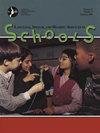Elementary School Speech-Language Pathologists' and Classroom Teachers' Collaboration Experiences.
IF 2.9
3区 医学
Q1 AUDIOLOGY & SPEECH-LANGUAGE PATHOLOGY
Language Speech and Hearing Services in Schools
Pub Date : 2025-09-10
DOI:10.1044/2025_lshss-24-00137
引用次数: 0
Abstract
PURPOSE Reviews of evidence have shown that elementary school students show enhanced speech, language, and/or literacy outcomes when speech-language pathologists (SLPs) and classroom teachers collaborate in planning and delivery of services. However, such collaboration is uncommon. The purpose of this qualitative interview study was to examine the experiences and views of elementary SLPs and classroom teachers in collaborating with one another. METHOD Semistructured interviews using matched sets of prompts were used to investigate the experiences and opinions of 13 SLPs and 16 elementary teachers regarding collaboration, specific scenarios of collaboration, and preferred collaborative models. A qualitative analysis was used to analyze the interviews. RESULTS The results support previous research findings that SLPs and teachers spend a low proportion of their time collaborating, and SLPs are rarely involved in classroom-based intervention. Teachers were favorably disposed toward classroom-based intervention. Both SLPs and classroom teachers expressed a wish to collaborate, but noted challenges including time, difficulty targeting goals in the classroom, and classroom distractions. Building relationships can increase the likelihood of collaboration occurring. CONCLUSIONS Both SLPs and classroom teachers agree that collaboration is desirable for supporting student success and that current practices are not ideal. SLPs and classroom teachers noted the importance of building relationships and expressing their willingness to engage in collaboration.小学言语语言病理学家与课堂教师的合作经验。
目的:对证据的回顾表明,当语言病理学家(slp)和课堂教师合作规划和提供服务时,小学生的言语、语言和/或读写能力得到了提高。然而,这样的合作并不常见。本质性访谈研究的目的是探讨小学小学低年级学童与任课教师合作的经验与观点。方法采用半结构化访谈法,对13名小学教师和16名小学教师在合作、具体合作场景和首选合作模式方面的经验和看法进行调查。采用定性分析对访谈进行分析。结果该结果支持了先前的研究结果,即小学生与教师合作的时间比例较低,小学生很少参与课堂干预。教师倾向于课堂干预。语言教师和课堂教师都表达了合作的愿望,但也指出了时间、难以确定课堂目标以及课堂干扰等挑战。建立关系可以增加合作发生的可能性。结论学生服务提供者和课堂教师都认为协作是支持学生成功的理想方式,但目前的做法并不理想。slp和课堂教师注意到建立关系和表达他们参与合作的意愿的重要性。
本文章由计算机程序翻译,如有差异,请以英文原文为准。
求助全文
约1分钟内获得全文
求助全文
来源期刊

Language Speech and Hearing Services in Schools
Social Sciences-Linguistics and Language
CiteScore
4.40
自引率
12.50%
发文量
165
期刊介绍:
Mission: LSHSS publishes peer-reviewed research and other scholarly articles pertaining to the practice of audiology and speech-language pathology in the schools, focusing on children and adolescents. The journal is an international outlet for clinical research and is designed to promote development and analysis of approaches concerning the delivery of services to the school-aged population. LSHSS seeks to advance evidence-based practice by disseminating the results of new studies as well as providing a forum for critical reviews and meta-analyses of previously published work.
Scope: The broad field of audiology and speech-language pathology as practiced in schools, including aural rehabilitation; augmentative and alternative communication; childhood apraxia of speech; classroom acoustics; cognitive impairment; craniofacial disorders; fluency disorders; hearing-assistive technology; language disorders; literacy disorders including reading, writing, and spelling; motor speech disorders; speech sound disorders; swallowing, dysphagia, and feeding disorders; voice disorders.
 求助内容:
求助内容: 应助结果提醒方式:
应助结果提醒方式:


